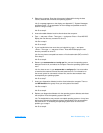
support.dell.com Basic Troubleshooting 3-23
6. Turn on the computer. Is the display on?
Allow one minute for the computer to initialize its components.
Yes. Go to step 7.
No. Go to step 9.
7. Press the <Fn> down-arrow or <Fn> up-arrow key combination to adjust the
brightness. Is the full display readable?
Yes. Go to step 8.
No. Go to step 9.
8. Has an error message appeared on the display, or has a beep code sounded?
Yes. Refer to Appendix C, “System Messages and Beep Codes,” to find the
message or beep code, along with its explanation. If you can’t find the message
or code, call Dell for technical assistance. (See Chapter 5, “Getting Help,” for
instructions.)
No. If you still have a display problem but the display is not completely blank,
run the Video device group in the Dell Diagnostics. Then call Dell for technical
assistance. (See Chapter 5, “Getting Help,” for instructions.)
9. Turn off your computer and connect an external monitor to the computer.
10. Turn on the computer and the monitor and adjust the monitor’s brightness and
contrast controls. Is the monitor readable?
Yes. The computer’s display may be defective. Call Dell for technical assistance.
(See Chapter 5, “Getting Help,” for instructions.)
No. The computer’s video controller on the system board may be defective. Call
Dell for technical assistance. (See Chapter 5, “Getting Help,” for instructions.)
Troubleshooting an External Monitor
During POST, the computer checks to see if an external monitor is attached to the
computer. If no image appears on the external monitor when the computer boots,
make a copy of the Diagnostics Checklist found in Chapter 5 and fill it out as you
perform the following steps:
1. Is the Video Display Device option in the Setup program set to LCD Mode?
Yes. If the Video Display Device option is set to LCD Mode, the computer
ignores the presence of an external monitor at system start-up. Go to step 2.
No. Go to step 2.


















